Twenty five years ago, on the evening of 9 November 1989, the Berlin Wall fell. Berlin had been on my travel wish list for a long time. With the 25th anniversary of the fall of the wall looming, I decided to put it off no longer.
The city did not immediately impress me. The apartment I rented for a week was in a 15-story high rise in the Kreuzberg area, just a ten minute stroll from the infamous Checkpoint Charlie that marked the border between the American and Soviet sectors in the days when there was still an East and West Berlin. From my 4th floor window I looked down on a sea of squat, uninteresting structures. Some of this uninspired architecture owes it’s existence to Hitler, who espoused a Nationalist style that valued function over form and eschewed even the most basic ornamentation. But to blame Hitler solely would be a mistake. By the end of World War Two, 60% of the city’s buildings had been razed and another 20% were unusable.
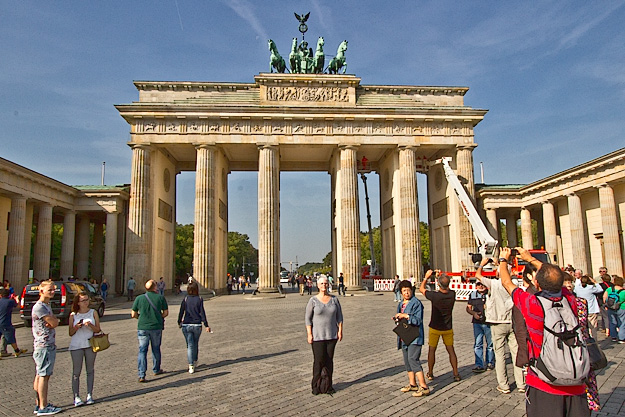
Russians troops, who reached the city in December of 1945, were intent upon revenge for the 20 million of their countrymen who had fallen. Berliners fought, not on behalf of the Third Reich, but in a desperate attempt to protect their families. After surrender, even the buildings still standing were pocked by mortar shells and bullet holes. Berlin was little more than a pile of bricks.
“It was women who rebuilt the city,” one of my tour guides from Context Walking Tours explained. “So many of the men had been killed in the war. Every day the women, my mother among them, would go to the streets to clean and stack the bricks so they could be reused.” In the face of such devastation, little consideration was given to designing beautiful buildings.
Though most of the Berlin Wall has long since been torn down, a double row of bricks embedded in the asphalt shows where it once stood. I came across these memorial bricks in unexpected places and straddled them, looking left and right. Which side had been west and which east was immediately apparent; buildings in what had been East Berlin are newer, as much of that part of the city has been reconstructed since reunification in 1990.
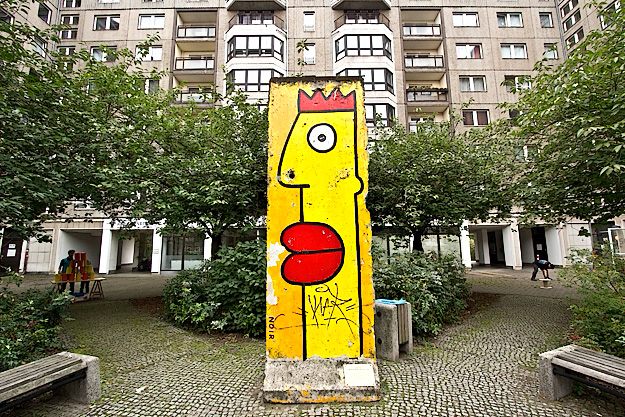
In some ways, Berliners (and perhaps all Germans) are still coming to grips with the events of the war. “Until the early 1990’s, I was taught history only up to 1933, my guide explained. “It was as if the world after 1933 did not exist.” A youth movement in the 90’s changed all that. The new generation insisted that their elders recognize the history of WWII and incorporate it into school textbooks.
I discussed this with a ticket agent the day I visited The Asisi Panorama – The Wall, a three-dimensional installation in the round that depicts a small section of the Berlin Wall at the height of the Cold War. She confirmed for me that the war was never spoken about until the last 20 or so years. “Now we understand that we must remember, so that the same mistakes are never made again.” But she cautioned me about speaking to elderly about this issue. “It is so terrible for them to remember that they just cry.” Not having personally experienced the horror, it was hard for me to imagine, but stepping inside the rotunda provided me with a small taste of life in Berlin during those desperate years. The scene that artist Yadegar Asisi has reproduced depicts a section of the wall that sliced through a neighborhood like a raw and putrefying wound, severing families and friends, in an attempt to stop the waves of people who were fleeing East Berlin.
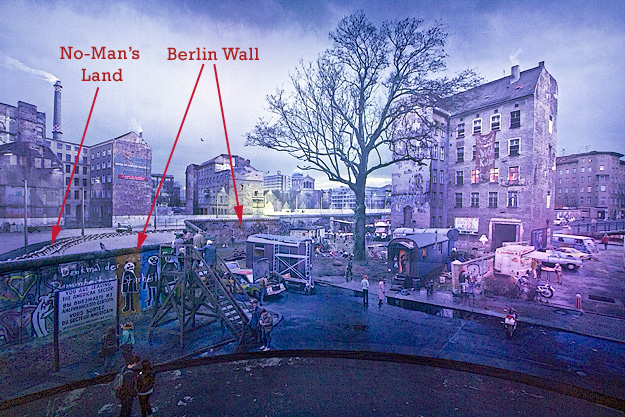
Though Berlin has been reunified since 1990, in some ways it remains a divided city. During the Cold War, the partitioning of the city placed the old town inside the Soviet sector, thus it became the de facto capital of East Germany. With access to their historic seat of government shut off, the Kurfürstendamm area in the far western part of the city developed into the new center of commerce, administration and culture for West Berliners. Today, the city still has two centers, located miles apart. The historic center is home to the Berliner Dom (Protestant Cathedral), as well as five of the top museums in the country (Pergamonmuseum, Bode-Museum, Neues Museum, Alte Nationalgalerie, and the Altes Museum), while Kurfürstendamm has become a shopping mecca, anchored by the eight-story Kaufhaus des Westens (Department Store of the West), shortened to KaDeWee by locals.
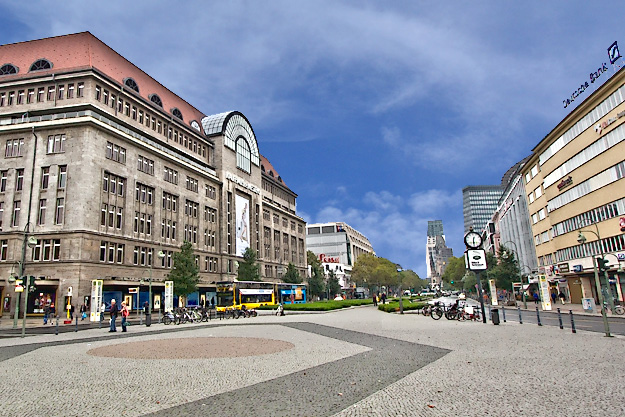
I spent one afternoon on the sixth floor of KaDeWee, which is entirely devoted to food. Ten feet from the elevator doors I was stopped in my tracks by a mouth-watering display of Truffles. Moments later, contentedly munching on chocolate delicacies, I resumed my tour of gourmet coffees and teas, fresh-baked breads, meats butchered to order on-the-spot, fresh-caught seafood, voluptuous fruits cradled in individual net sheaths, and a dairy department that offered more than 1,800 types of cheese. In the center of it all stood my nirvana: a deli case stuffed with roasted root vegetables, fresh pastas, feta-stuffed peppers, and a myriad of salads.
Eschewing my rudimentary German, I pointed to what I wanted and climbed up onto a high stool at the adjacent counter, where I spent a contented hour shoving food into my face while watching some of the 180,000 customers that are served by the store’s 2,000 employees each day. Later, wandering further into the district, the contrast between the old East and West Berlin became even more conspicuous. Contemporary sculptures studded the median strip of a broad boulevard lined with designer stores. A McDonald’s offered two floors of parlors equipped with cozy fireplaces and overstuffed chairs.
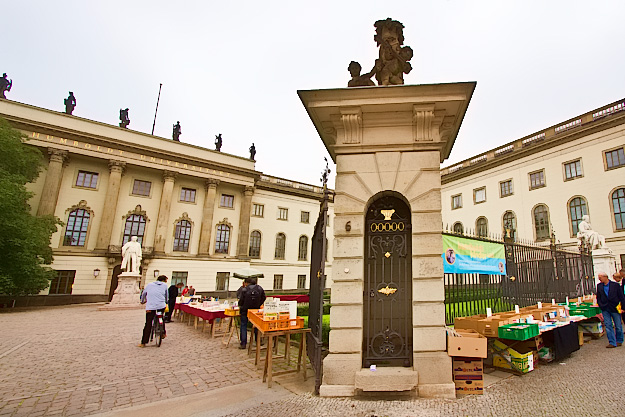
Each day, I encountered startling paradoxes that echoed Berlin’s dual city centers. In 1933, students from Humboldt University gleefully tossed books from the library into a bonfire during a Nazi-mandated book burning ceremony. Today, street vendors hawk books from portable tables set up at the front entrance to the university. At the Berlin Wall Memorial, visitors strolled across a broad unblemished lawn, beneath which lie uncounted graves from a church and graveyard razed by the Nazis.
The historic site of the Berlin Palace, however, may be Berlin’s greatest incongruity. Originally the residence of the Hohenzollern Kings of Prussia, the palace was converted to a museum when the German Empire fell in 1918 and the Hohenzollerns were deposed. Although the heavy damage it suffered from bombing during WWII could have been repaired, East German authorities decided to demolish the palace. It was replaced with the “Palace of the Republic,” a squat, bronze-mirrored monstrosity that housed the parliament of the GDR, along with art galleries, a theater, 13 restaurants, a bowling alley, post office, and a discotheque. Just prior to German reunification, this new palace was found to be severely contaminated with asbestos and was demolished. Today, a new convention and meeting center is rising on the site. Three of its four facades will be faithful reconstructions of the original imperial Berlin Palace. Twenty-five years after the fall of the wall, Berlin still seems to be searching for an identity.
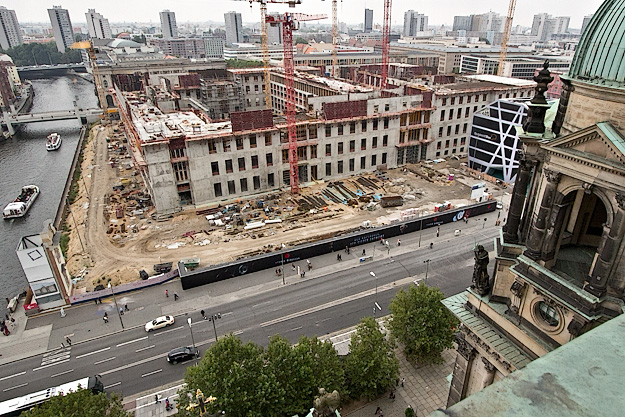
Yet this very uncertainty may be what makes Berlin such an intriguing travel destination. A spirit of exploration, of experimentation, pervades the German capital. Still one of the most affordable places to live in western Europe, Berlin draws starving artists like a magnet. As a result, the city is a veritable cornucopia of dance halls, cinemas, theaters, bars, clubs, galleries, concerts, festivals – even old industrial sites on the River Spree have been converted to entertainment hot spots. Berlin is the kind of city that grows on you; as my visit drew to a close, I wished I’d planned to stay more than a week. On my final evening, I met with Natallie Holmes, who relocated to Berlin several years ago to accept the position of Central European Cities Manager for Context Travel, which provided my walking tours of the city. She summed up the essence of Berlin perfectly. “In London, the future has already been decided. In Berlin, everything is possible.”
Note: Berlin will celebrate the 25th Anniversary of the Fall of the Wall with a series of special events between November 7-9. 8,000 helium balloons, each sponsored by a patron who has placed a written message of peace inside their balloon, will trace the former course of the Berlin Wall. The exhibition, One Hundred Berlin Wall Stories – One Hundred Times Berlin, will offer recollections and facts from the days when the wall was a scar on the landscape of Berlin. Brandenburg Gate will be the site of a festival and live musical performances, including one by Peter Gabriel. The three-day event will close on the evening of November 9th with a mass release of the peace balloons into the night sky. For more information, visit Fall of the Wall 2014.
Disclosure: Many thanks to Visit Berlin, which provided me with a Berlin Welcome Card for public transportation around the city, as well as complimentary access to The Wall and two Context Walking Tours of Berlin: ‘The Story of Berlin’ and ‘Walking the Wall.’ I have been fortunate to take Context walking tours in a number of cities and have always been impressed with their level of knowledge and the professionalism of their guides. As always, in the case of Berlin, the tours were superlative.

Great post I like it.Berlin in the Wonderful Country.Thanks for sharing.
It represent that berlin is more powerful country and have advanced technology..
I’m so glad you got to visit the city that I consider my second home. I agree with everything you’ve written (particularly the food floor of KaDeWe — yum) and want to add a further thought. In my opinion Berlin is the classic example of the post-consumer society, where unlike cities like New York or London, money does NOT rule or the tipping point for every decision. From my group of friends, projects or work are not driven by the revenue they bring, but by the non-financial benefits. I’ve seen Berlin grow up over the last 20 years and really like what I see.
Hi Tonya: What you wrote is very thought provoking. I really dislike the overly commercialized lifestyle in the U.S., so I wonder if the essence of life in Berlin is what I sensed and liked. Thanks for sharing that.
Tonya,
Great to hear from somewhat of a “local” to the area. I have often heard of Berlin, but have not had much of a desire to visit. However, your perspective on the culture and the “money does NOT rule” is refreshing. I have grown tired of commercialization in America (which is part of what made me want to start traveling). I am no eager to get to Berlin and experience this place and culture. I feel it will really resonate with me.
Thank you both for sharing.
I can understand how the city takes time to grow on you. Andy and I spent 3 months living in Berlin last year when he had a contract up there, and we absolutely fell in love with it. It’s so different from the rest of the country, so gritty, so international, so much energy. In any other city, those boring blocky buildings would make for a drag atmosphere, but in Berlin you realize why they have those buildings and it’s like getting a tiny glimpse at the past. Berlin’s story is fascinating to me. My favorite tourist spot was Bernauerstrasse because of all the information about the time leading up to the wall and what life was like when the wall was there and how it affected the city and that neighborhood. But there is still so much of the city I didn’t get to see or experience, even in 3 months. I’m glad you went and enjoyed your time there, but I agree that a week isn’t long enough!
Hi Ali: I remember that you spent a few months in Berlin, and I’m fascinated that you still didn’t see everything. It’s an incredible city, with many layers. I also really enjoyed the Berlin Wall Memorial at Bernauerstrasse; I stayed for hours, listening to all the recordings and reading the stories of people who escaped or attempted to escape.
Thanks for your Analysis you have discussed it in detail plus the Panoramic art installed is very elaborative.
You’re welcome, Mian.
I was fortunate to have visited Berlin in 1985. I saw the wall by the Brandenburg Gate, Check Point Charlie, visited KaDeWe, and even was allowed to go on a tour of East Berlin and saw a Soviet War memorial there. I remember the West side was definitely a haven for artist, and basically, I have pleasant memories of that visit. Reading your article, I would love to visit there again, perhaps someday soon!!! The history, the museums, and just the atmosphere or mood of the City are quite appealing to me, and your article has brought back pleasant memories! Thank you for posting your article! 🙂
You’re very welcome, Ken. I wish I had visited back then. It would have been quite amazing to wander around and compare how things look today with the ay they were back in 1985.
Berlin is a city with an amazing history, present, and future. I took a free tour while there that gave great info on the neighborhood you stayed, Kreuzberg (so did I!). Mostly stories about protest and social justice, I fell more in love with the neighborhood as a result. I stayed 2 weeks and still felt like it wasn’t enough, so definitely go back again!
I agree, Rikka! A week was barely enough to scratch the surface, but enough to know that there’s so much more to the city than meets the eye.
Berlin has a fascinating history … can’t wait to spend some serious time in this affordable and interesting European capital!
Hi Selma: Hope you can visit Berlin some day – maybe consider next year, when they will have a huge celebration for the 25th anniversary of the reunification of Germany.
A city I have never been to despite being in Germany on four different occasions (but mainly favouring the south and its mountains and forests). I love your take on the Berlin and find that people seem to really love it or a bit cold towards it. I have never really understood that.
Hi Mark: How interesting! This was my first trip to Germany, and I specifically chose Berlin. I’d bet that the people who did nt like Berlin are those who only stayed a few days. I’d go back in a heartbeat.
I’d like to admit that Berlin is one of the few cities of Europe that doesn’t appeal to me at all! But your take on it has intrigued me. I want to explore it the way you did! There is a difference between sightseeing on the surface and getting deeper into the soul of a city.
Hi Renuka: Thank you for your comment. I’m also of the belief that travel should be about delving deeper into a culture, rather than just visiting a few iconic sights. Berlin takes a while to sink into your skin, but once it does, it’s terribly intriguing.